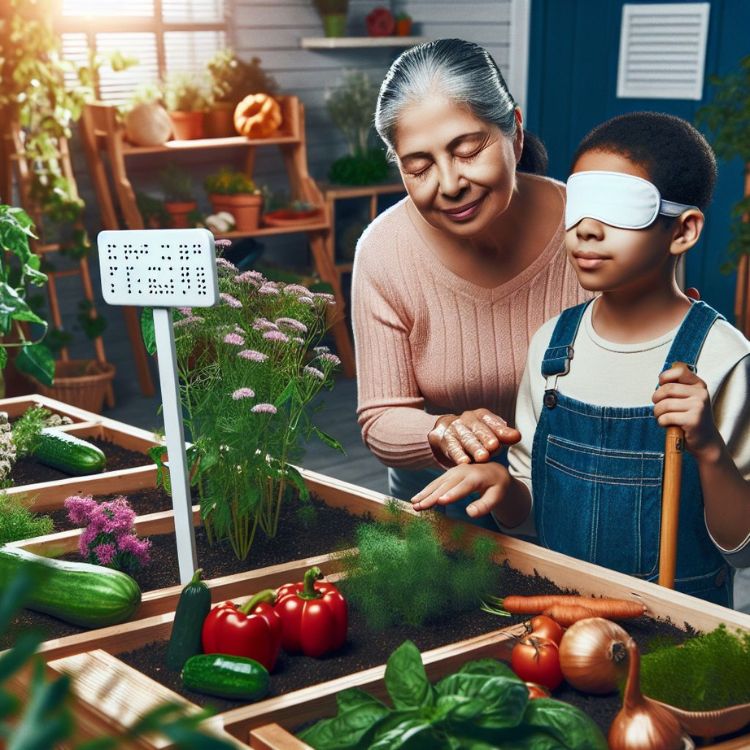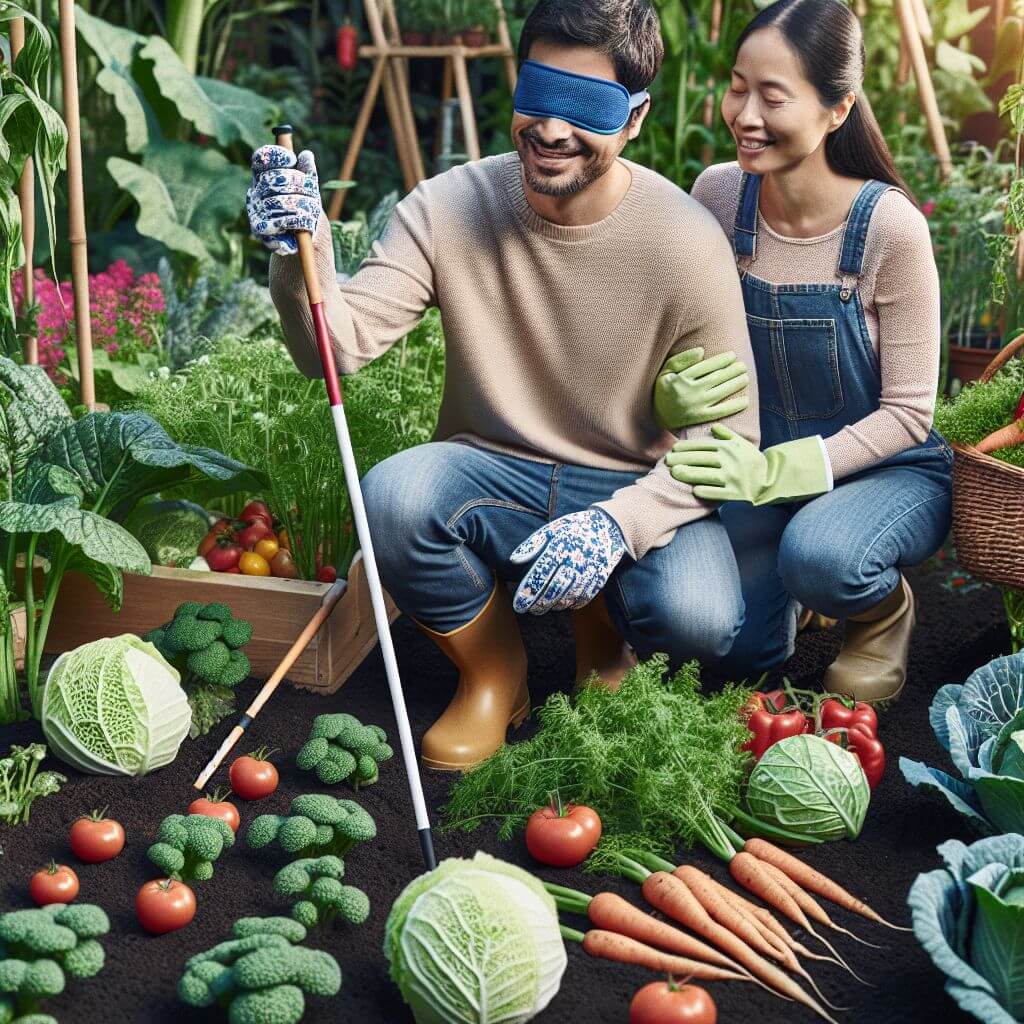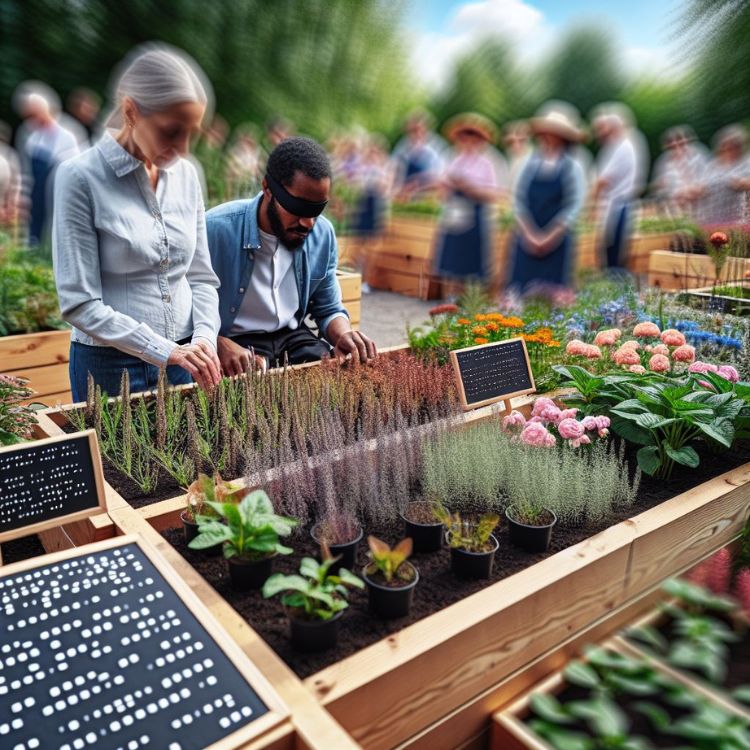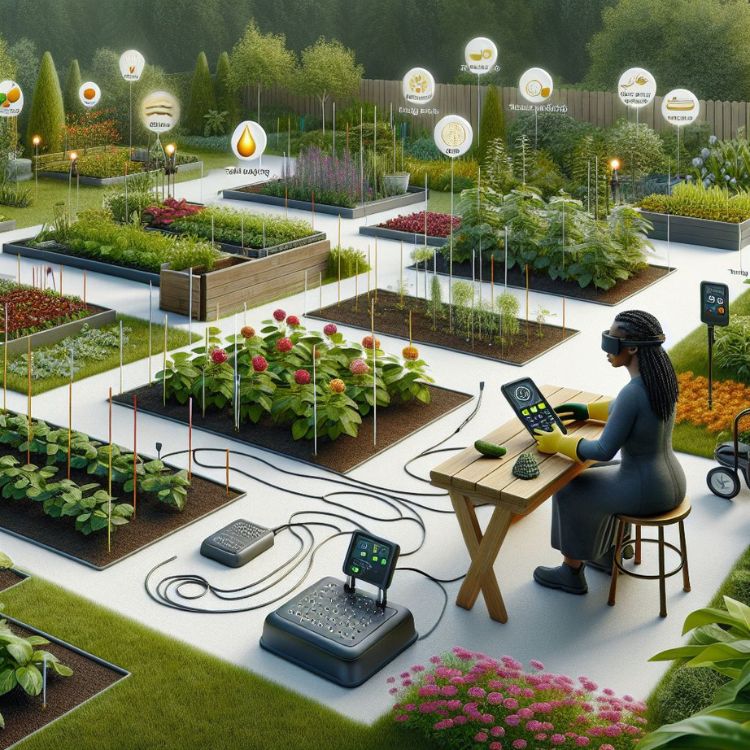
In the symphony of life, everyone deserves a chance to enjoy the wondrous melody of nature. Despite our differences, we all share the ability to appreciate the profound beauty that gardening brings. This universal truth extends even to the visually impaired, to whom the world of gardening offers a unique and sensory-rich experience.
Key Takeaways
- Gardening for the blind is an opportunity to embrace life’s sensory wonders and transform challenges into opportunities.
- With the right tools and techniques, visually impaired individuals can experience joy, discovery, and personal growth through gardening.
- Engaging in gardening can provide a fulfilling and enriching experience for those who are visually impaired.
- Cultivating plants and tending to a garden can offer a sense of accomplishment and connection to nature.
- Gardening can stimulate the senses and create a sensory-rich environment for individuals with visual impairments.
- Adapted gardening tools and techniques can make it easier for visually impaired individuals to participate in gardening activities.
- Maintaining a positive outlook and embracing the possibilities that gardening offers can enhance the overall well-being of visually impaired individuals.
Unlocking the Joys of Gardening for the Blind

The joy of nurturing life from a single seed, feeling it grow beneath your fingertips, and harvesting the fruits of your labor transcends vision. This unique blend of science, art, and nature opens a world of possibilities for those with visual impairments. Every sprouting seed is a tangible reminder that life always finds a way to thrive, and you are a part of that journey.
Discover the Sensory Benefits
Gardening for the blind is not merely about growing plants; it’s about growing oneself. The garden becomes an extension of one’s senses—a living tapestry that you weave with your hands. The sweet scent of lavender on a warm summer day, the symphony of rustling leaves in the breeze, or the textured surfaces of different plants can all be powerful stimulants that sharpen one’s sensory perception.
Embrace Nature with Confidence
The garden offers a safe haven—a place where you can engage in physical activity and foster a deep sense of connection with nature. The act of gardening cultivates resilience and self-confidence in dealing with life’s challenges, transforming everyday tasks into opportunities for personal growth and discovery.
The Aromatic Garden: Cultivating Scents and Textures
In creating a sensory garden for the visually impaired, consider plants that stimulate through their scent and texture. An aromatic garden can be filled with fragrant herbs like rosemary and thyme or flowers like roses and lilies that release an enchanting perfume into the air. Similarly, different plants offer an array of tactile experiences—from soft lamb’s ear to feathery ferns and textured bark of shrubs.
Choosing Fragrant Plants for a Sensory Experience
When selecting plants for your aromatic garden, focus on those with distinctive and pleasing scents. Consider incorporating various types of mint, basil, and sage for their powerful and distinctive fragrances. In addition to providing sensory stimulation, these plants have the added benefit of being edible, turning your garden into a veritable feast for the senses!
Designing a Garden with Texture in Mind
Much like a quilt is composed of different fabric pieces, a sensory garden thrives on diversity. It’s all about combining plants with varying textures—fuzzy, smooth, rough, or prickly—to provide a rich tactile experience. Combine vegetables like the bumpy skin of pumpkins, the smooth leaves of chard, and the fuzzy surfaces of kiwi fruits to create an exciting sensory adventure.
Herbs and Flowers That Stimulate the Senses
Herbs like basil, rosemary, and thyme are excellent choices for visually impaired gardeners as they offer a distinct tactile experience with their textured leaves and strong scents. On the other hand, flowers like lilies, roses, and marigolds not only add delightful fragrance but also attract beneficial pollinators with their vibrant colors.
Survival Skills: Nurturing Resilience Through Gardening
Gardening is more than a recreational activity; it’s a valuable survival skill that fosters resilience. Tending to plants instills patience, persistence, and problem-solving abilities—traits vital in life’s journey. It’s empowering to grow your own food, making you more self-sufficient and less reliant on grocery stores.
Growing Food for Self-Sufficiency
Planting and cultivating your food gives you control over what you consume. Cultivating heirloom seeds not only preserves biodiversity but also ensures access to nutritious food year-round. Whether it’s tomatoes brimming with sun-ripened sweetness or crisp, home-grown lettuce, nothing compares to the satisfaction of a meal made with your garden’s bounty.
Heirloom Seeds: A Legacy of Taste and Nutrition
Heirloom seeds are a treasure trove of unique flavors and nutritional benefits, preserved by generations of gardeners. They offer an unmatched diversity of crops that have been adapted to specific climates and conditions, resulting in robust plants with superior flavor and nutritional profiles. Choosing these seeds is an investment in your health and our shared agricultural heritage.
Adaptive Tools and Techniques for Independence
With the right tools, gardening can be accessible and enjoyable for everyone. There are adaptive tools designed to assist blind gardeners—like trowels with easy-grip handles, adjustable rakes for comfort, and even talking thermometers! It’s all about finding what works best for you and adapting it to your needs.
Navigating the Garden: Layouts and Paths for the Visually Impaired

Navigating the Garden: Layouts and Paths for the Visually Impaired
A well-organized garden layout can significantly enhance the gardening experience for visually impaired individuals. Incorporate wide, clear paths to facilitate navigation between different garden sections. Use raised beds or containers for easy access and create tactile markers to identify specific plants or garden beds.
Creating Safe and Accessible Garden Layouts
To ensure safety and ease of navigation in the garden, consider incorporating features like guide ropes or railings along paths. Raised beds or vertical gardens can make tending plants easier by bringing them to a comfortable height. Additionally, keeping tools in designated places helps maintain order and accessibility.
Guiding Pathways and Tactile Markers
Clear paths are essential in any garden design, but particularly so for visually impaired gardeners. Try using contrasting materials like pebbles, gravel, or bark chips to differentiate paths from planting areas. Tactile markers can be as simple as large stones, wind chimes at different garden sections, or different textured edgings.
Organizing Plants for Easy Accessibility
Organizing your plants by type and height can make gardening tasks simpler. Group similar plants together and arrange them by their height, with taller plants at the back of the garden or in the center of a circular bed. This logical organization aids in remembering plant locations and makes maintenance tasks more manageable.
The Therapeutic Touch: Health Benefits of Garden Interaction
Gardening is a holistic activity that offers numerous health benefits. It’s a natural stress reliever, encouraging relaxation and fostering a sense of achievement. Gardening also promotes physical activity, improving flexibility and strength. It provides an outlet for creativity and personal expression, enhancing mental wellbeing.
Mental Wellbeing Through Connection with Nature
There’s something inherently therapeutic about connecting with nature. The act of planting a seed, nurturing its growth, and witnessing its life cycle brings us closer to nature’s rhythms. This engagement helps reduce anxiety, improve mood, and foster a greater appreciation for life’s little wonders.
Physical Fitness and Motor Skills Development
Gardening is an excellent form of exercise that works various muscle groups. Digging, planting, weeding, and harvesting all contribute to physical fitness, promoting strength and flexibility. Additionally, it enhances motor skills through actions that require coordination, like handling seeds or using gardening tools.
Social Interaction and Community Involvement
Gardens are magical spaces that bring people together. They foster community interaction—be it through gardening clubs, community garden projects, or simply sharing produce with neighbors. They provide opportunities for mentoring and learning from others’ experiences, making gardens not just places for plants but also for nurturing human connections.
Garden Tech: Innovations for Blind Gardeners

Innovation is transforming the gardening experience for visually impaired individuals. From audible alerts that signal watering needs to apps identifying plants through audio descriptions—technology is making it easier than ever to enjoy the thrill of gardening.
Audible Alerts and Sensory Devices
Imagine a device that sings when your plant needs watering or a sensor that beeps when it’s time to harvest your tomatoes. Such devices are not mere imagination but a reality. They can significantly enhance the gardening experience by making care tasks easier and more accessible.
Apps and Assistive Technology for Plant Care
Today, there are numerous mobile apps and technologies designed to assist visually impaired gardeners. These include plant identification apps, audio-based garden guides, and virtual assistant tools—all geared towards making plant care information easily accessible.
Heirloom Seeds: Secure Your Future with a Click
With the advent of e-commerce, acquiring heirloom seeds is just a click away. Online platforms offer a wide variety of heirloom seeds, complete with detailed descriptions and planting instructions. This technology is revolutionizing the way we access and preserve our agricultural heritage.
Planting Tactics: From Seed to Harvest
Planting tactics for visually impaired gardeners often involve creating tactile guidelines. For instance, using a string as a guide when sowing seeds or creating raised furrows helps in maintaining straight rows. Remember, gardening is an exploration of what works best for you—don’t be afraid to experiment and find your unique method.
Seed Starting Tips and Tricks
Starting seeds can be quite rewarding, as you nurture life from the very beginning. Consider using peat pots or seed starting trays with large cells for easy handling. Adding a tactile marker like a toothpick next to each seed can help keep track of growth progress.
Care Techniques for Different Plant Stages
Each stage of plant growth—from germination to maturity—requires different care techniques. This process can be made simpler with mnemonic devices or routine practices that align with the plant’s needs. For instance, associating specific care tasks with specific days of the week can make remembering them easier.
Harvesting Methods That Empower.
The act of harvesting your home-grown produce can be incredibly empowering. With the right techniques, it can also be an enjoyable activity that enhances your gardening experience. For instance, learning to identify ripe fruits and vegetables by touch or smell can turn harvesting into a delightful sensory exploration.
FAQ
What Are the Best Plants for a Sensory Garden?
The best plants for a sensory garden are those with distinct features that engage various senses. Consider adding plants with various textures, such as lamb’s ear for its fuzzy leaves or ferns for their delicate fronds. For scent, herbs like rosemary, mint, or basil offer a powerful and stimulating fragrance. Edible plants like tomatoes or bell peppers can offer not only tactile stimulation but also taste. Lastly, plants with unique sounds—like the rustling of bamboo in the wind—can also enhance the sensory experience.
How Can I Organize My Garden for Easy Navigation?
A well-organized garden can significantly improve your gardening experience. Here are some tips: First, plan your garden layout thoughtfully with wide, clear paths that allow easy movement. You can use different textures on the ground to distinguish between paths and planting areas. Second, use raised beds or containers to bring the plants closer to hand level, and organize them logically by type or height for easy recognition. Third, consider incorporating tactile markers—like large stones or wind chimes at the beginning of each section—to help identify different areas of your garden.
What Gardening Tasks Can Enhance Tactile Sensation?
Various gardening tasks can help enhance tactile sensation. These include:
- Planting Seeds: This involves handling small seeds and placing them into soil.
- Weeding: It requires identifying unwanted plants by touch.
- Pruning: This involves identifying branches that need cutting.
- Harvesting: Picking ripe fruits or vegetables can be a sensory treat, as you’ll need to recognize them by their texture and firmness.
- Soil Preparation: Feeling the texture of the soil and modifying it as needed provides varied tactile experiences.
Which Garden Technologies Are Most Helpful for the Blind?
Several innovative technologies have made gardening more accessible for the blind. These include:
- Talking thermometers that provide temperature readings out loud.
- Audible alerts and sensors that signal when plants need watering or are ready for harvesting.
- Apps that can identify plants and provide care instructions through voice recognition and response.
- Tactile markers that can be placed around the garden to help visually impaired gardeners navigate their space.
Where Can I Find Resources for Blind Gardeners?
There are several resources available for blind gardeners. Numerous online platforms offer detailed guides on adaptive gardening techniques, tools, and tips. Organizations like the American Foundation for the Blind provide resources on gardening with visual impairments. Local horticultural societies, garden clubs, and extension services often have resources or workshops on accessible gardening. Moreover, online forums and social media groups offer a platform for blind gardeners to share their experiences and advice.
Remember, every garden is a story about the gardener who tends it. Each plant carefully nurtured, each bloom lovingly tended to, weaves a tale of dedication and passion. So go ahead and start writing yours!
Ready to begin your own gardening journey? Visit Survival Essentials to purchase high-quality seeds and start turning your garden into a masterpiece! Click the button below to buy seeds now:






